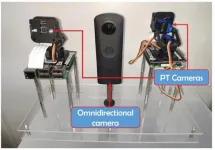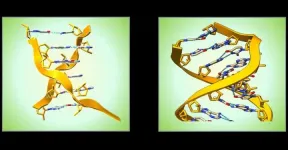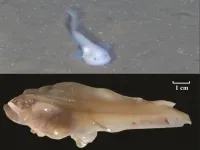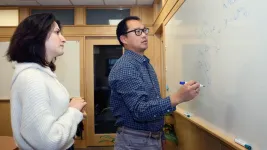(Press-News.org) If you're a fan of spy movies, you've probably come across scenes where the intelligence agents try to identify or detect a perpetrator using some sophisticated image enhancement technology on surveillance camera images. While the idea behind surveillance cameras and object detection is the same in real life, unlike in movies, there is often a trade-off between the camera's field-of-view and its resolution.
Surveillance cameras are typically required to have a wide field-of-view to make the detection of a threat more likely. Due to this, omnidirectional cameras allowing a 360-degree capture range have become a popular choice, for the obvious reason that they leave out no blind spot but also because they're cheap to install. However, recent studies on object recognition in omnidirectional cameras show that distant objects captured in these cameras have rather poor resolution, making their identification difficult. While increasing the resolution is an obvious solution, the minimum resolution required, according to a study, is 4K (3840 X 2160 pixels), which translates to enormous bitrate requirements and a need for efficient image compression.
Moreover, 3D omnidirectional images often cannot be processed in raw form due to lens distortion effects and must be projected onto 2D first. "Continuous processing under high computational loads incurred by tasks such as moving object detection combined with converting a 360-degree video at 4K or higher resolutions into 2D images is simply infeasible in terms of real-life performance and installation costs," says Dr. Chinthaka Premachandra from Shibaura Institute of Technology (SIT), Japan, who researches image processing.
Addressing this issue in his latest END
Two-in-one: Wide-angle monitoring meets high-resolution capture in new camera platform
Researchers construct a dual hybrid camera system enabling a 360-degree monitoring for target detection and its capture in high resolution
2021-05-13
ELSE PRESS RELEASES FROM THIS DATE:
The first frost is the deepest
2021-05-13
The first frost of autumn may be grim for gardeners but the latest evidence reveals it is a profound event in the life of plants.
The discovery may affect how we grow crops in a fluctuating climate and help us better understand molecular mechanisms in animals and humans.
Much of our understanding of how plants register temperature at a molecular level has been gained from the study of vernalization - the exposure to an extended period of cold as a preparation for flowering in spring.
Experiments using the model plant Arabidopsis have shown how this prolonged period of cold lifts the brake on flowering, a gene called FLC. This biochemical brake also involves another molecule COOLAIR which is antisense to FLC. This means it lies on the ...
Knowledge gaps on opioid use after surgery offer opportunities for improving patient education
2021-05-13
Researchers at Hospital for Special Surgery (HSS) have identified gaps in patient knowledge about pain management and opioid use before total hip replacement, including misconceptions about how much pain relief to expect from opioids after surgery, how to use multiple modes of pain relief (multimodal analgesia) safely and effectively, and proper opioid storage and disposal. These findings were presented at the 2021 Spring American Society of Regional Anesthesia and Pain Medicine (ASRA) Annual Meeting.1
"Patients who are not taught about opioids and pain management may have difficulty with pain control and worse functional outcomes after total ...
Study identifies risk factors for pediatric opioid dependence after surgery
2021-05-13
Researchers at Hospital for Special Surgery (HSS) have identified risk factors for persistent opioid use after surgery in pediatric patients.1 Study findings were presented at the 2021 Spring American Society of Regional Anesthesia and Pain Medicine (ASRA) Annual Meeting.
Previous research indicates that prescription patterns for opioids after surgery in children and adolescents may be associated with long-term use and abuse.2
"Pediatric patients have developing brains that are uniquely vulnerable to addiction, and we need to learn to treat their pain safely without putting them at additional ...
UChicago study finds lasofoxifene a promising treatment for resistant breast cancer
2021-05-13
In a study carried out in mice at the University of Chicago, researchers found that lasofoxifene outperformed fulvestrant, the current gold-standard drug, in reducing or preventing primary tumor growth. It also was more effective at preventing metastasis in the lung, liver, bone and brain, the four most common areas for this cancer to spread.
Additionally, while fulvestrant and similar drugs often cause unwanted, menopausal-like side effects, lasofoxifene prevents some of these symptoms. The research was published on May 13 in END ...
Understanding how people make sense of the news they consume
2021-05-13
How people consume news and take actions based on what they read, hear or see, is different than how human brains process other types of information on a daily basis, according to researchers at the University of Missouri School of Journalism. While the current state of the newspaper industry is in flux, these journalism experts discovered people still love reading newspapers, and they believe a newspaper's physical layout and structure could help curators of digital news platforms enhance their users' experiences.
"Many people still love print newspapers, and to an extent, we also see that they like the digital replicas of print newspapers as much as they do the physical version," said Damon Kiesow, a professor of journalism professions and co-author on the study. "But we believe there ...
A Z-RNA nanoswitch encoded by "junk DNA" turns-off immune responses against self
2021-05-13
In a paper published in the May 13th, 2021 issue of PLOS Genetics, a Z-RNA nanoswitch that regulates interferon immune responses is described. The switch, less than 5 nanometer in length, is based on sequences, called flipons, that change outcomes by altering their three dimensional conformation. The Z-RNA nanoswitch flips from the shorter right-handed A-RNA helix ("on") to the longer left-handed Z-RNA helix ("off"). The flip ends immune responses against self RNAs, but not against viruses. Surprisingly, the Z-RNA nanoswitch sequence is encoded by "junk DNA". The Z-RNA nanoswitch is used by some cancers to silence anti-tumor immune responses. In other cases, a malfunction of the Z-RNA nanoswitch causes inflammatory disease.
In the ...
A sibling-guided strategy to capture the 3D shape of the human face
2021-05-13
A new strategy for capturing the 3D shape of the human face draws on data from sibling pairs and leads to identification of novel links between facial shape traits and specific locations within the human genome. Hanne Hoskens of the Department of Human Genetics at Katholieke Universiteit in Leuven, Belgium, and colleagues present these findings in the open-access journal PLOS Genetics.
The ability to capture the 3D shape of the human face--and how it varies between individuals with different genetics--can inform a variety of applications, including understanding human evolution, planning for surgery, and forensic sciences. ...
Two regions in the canine genome explain one third of the risk of rare blood cancer
2021-05-13
Mutations in two genetic regions in dogs explain over one third of the risk of developing an aggressive form of hematological cancer, according to a study led by Jacquelyn Evans and Elaine Ostrander at the National Human Genome Research Institute in Maryland, USA and colleagues. The study, which combined multiple sequencing techniques to investigate histiocytic sarcoma in retriever dogs, publishes May 13 in the open-access journal PLOS Genetics.
Histiocytic sarcoma is an aggressive cancer of immune cells, and although extremely rare in humans, it affects around one-in-five flat-coated retrievers. Genome-wide association surveys of 177 affected and 132 unaffected flat-coated ...
New snailfish genome reveals how they adapted to the pressures of deep-sea life
2021-05-13
A new whole genome sequence for the Yap hadal snailfish provides insights into how the unusual fish survives in some of the deepest parts of the ocean. Xinhua Chen of the Fujian Agriculture and Forestry University and Qiong Shi of the BGI Academy of Marine Sciences published their analysis of the new genome May 13th in the journal PLOS Genetics.
Animals living in deep-sea environments face many challenges, including high pressures, low temperatures, little food and almost no light. Fish are the only animals with a backbone that live in the hadal zone--defined as depths below 6,000 meters--and hadal snailfishes live in at least five separate marine trenches. Chen, Shi and their colleagues constructed a high-quality whole genome sequence from the Yap ...
Making AI algorithms show their work
2021-05-13
Artificial intelligence (AI) learning machines can be trained to solve problems and puzzles on their own instead of using rules that we made for them. But often, researchers do not know what rules the machines make for themselves. Cold Spring Harbor Laboratory (CSHL) Assistant Professor Peter Koo developed a new method that quizzes a machine-learning program to figure out what rules it learned on its own and if they are the right ones.
Computer scientists "train" an AI machine to make predictions by presenting it with a set of data. The machine extracts a series of rules and operations--a model--based on information it encountered during its training. Koo says:
"If you learn general ...
LAST 30 PRESS RELEASES:
University of Oklahoma researcher awarded funding to pursue AI-powered material design
Exploring how the visual system recovers following injury
Support for parents with infants at pediatric check-ups leads to better reading and math skills in elementary school
Kids’ behavioral health is a growing share of family health costs
Day & night: Cancer disrupts the brain’s natural rhythm
COVID-19 vaccination significantly reduces risk to pregnant women and baby
The role of vaccination in maternal and perinatal outcomes associated with COVID-19 in pregnancy
Mayo Clinic smartwatch system helps parents shorten and defuse children's severe tantrums early
Behavioral health spending spikes to 40% of all children’s health expenditures, nearly doubling in a decade
Digital cognitive behavioral treatment for generalized anxiety disorder
Expenditures for pediatric behavioral health care over time and estimated family financial burden
Air conditioning in nursing homes and mortality during extreme heat
The Alps to lose a record number of glaciers in the next decade
What makes a good proton conductor?
New science reporting guide published for journalists in Bulgaria
New international study reveals major survival gaps among children with cancer
New science reporting guide published for journalists in Turkey
Scientists develop a smarter mRNA therapy that knows which cells to target
Neuroanatomy-informed brain–machine hybrid intelligence for robust acoustic target detection
Eight SwRI hydrogen projects funded by ENERGYWERX
The Lundquist Institute and its start-up company Vitalex Biosciences Announces Strategic Advancement of Second-Generation fungal Vaccine VXV-01 through Phase 1 Trials under $40 Million Competitive Con
Fine particles in pollution are associated with early signs of autoimmune disease
Review article | Towards a Global Ground-Based Earth Observatory (GGBEO): Leveraging existing systems and networks
Penn and UMich create world’s smallest programmable, autonomous robots
Cleveland researchers launch first major study to address ‘hidden performance killer’ in athletes
To connect across politics, try saying what you oppose
Modulating key interaction prevents virus from entering cells
Project explores barriers to NHS career progression facing international medical graduates
Jeonbuk National University researchers explore the impact of different seasonings on the flavor perception of Doenjang soup
Two Keck Medicine of USC Hospitals named Leapfrog Top Teaching Hospitals
[Press-News.org] Two-in-one: Wide-angle monitoring meets high-resolution capture in new camera platformResearchers construct a dual hybrid camera system enabling a 360-degree monitoring for target detection and its capture in high resolution




